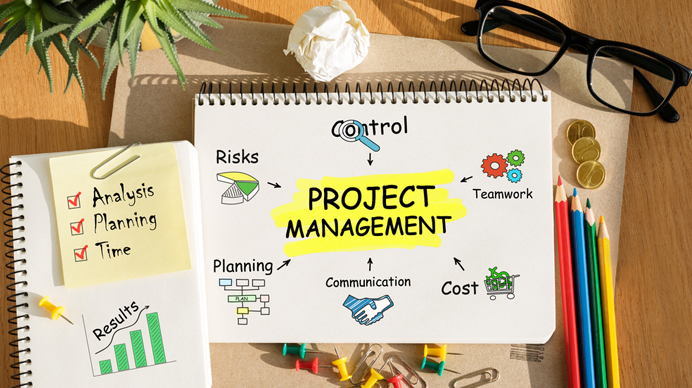5 Critical Stages of the Strategic Project Management Process
Project Management is not a cakewalk. Buckle up to nail it right on the head with a series of crucial phases.
In the hustle & bustle of in-house operations, teamwork, & productivity, effective project management becomes a daunting task for every newbie. Minor disorientation will disorganize the entire project that will make it a bit challenging to implement the strategies corresponding to the key motive behind its progress. A project is defined as a series of tasks that must be completed to reach the desired outcome. So, lack of project planning will not only disrupt your performance but also impart an adverse impact on the willpower of each & every entity or individual involved in the project.
Take a moment to mark a full stop on your worries and rub away all the question marks on how to strategize for effective project management. Here, we are elaborating 5 crucial phases of the project management process to help you throughout the project cycle. But before moving ahead, it is prerequisite to know the basics of project management & here are they:
Key features of a Project
- It is unique
- Has a defined timescale; Start and Finish dates
- Has an approved budget; with limited resources
- Involves an element of risk, and achieves beneficial changes
- Emerges due to Market demands, Organizational needs, customer request, Technological advances, Legal Requirements
- Achieves beneficial changes.
- The project progresses in steps and continues by increments.
To run any project, two methodologies are required:
- Project Life Cycle
- Project Management Process
1. Project Life Cycle
From scope planning to detailed designing, coding, testing, & strategic implementation, this phase involves all sequential steps of various phases of the Project. It also verifies that project work is aiming to produce high-quality software that meets or exceeds customer expectations.
2. Project Management Process
Project Management is a complementary discipline that helps to organize the project into a structured and streamlined process. It connects all the project activities and processes and makes team collaboration more efficient. It aims to achieve completion of high-quality software within times and cost estimates. When it comes to project management, there are plenty of activities. However, these management activities can be categorized into five main processes.
Initiation Process: “Authorize the Work”
Project initiation is the starting point of any project. Before you can execute or even plan a project you have to show that there’s a need for it. It outlines the Business case, Stakeholder Register, and Feasibility Study.
a. Business Case
A business case defines the reason behind the initiation of the project. It aims to ensure that resources such as money, time, & workforce consumed or used for a specific project will yield the outcomes in the company’s favour.
b. Stakeholder Register
A stakeholder register is a document that describes who is affected by a project, and their effect and impact on the project.
c. Feasibility Study
To evaluate what the project’s goals are, the timeline to completion and how much the whole endeavour will cost. Before the project is approved or rejected, these documents are created to sell the work to stakeholders or sponsors.
Planning Process: “Plan the Work”
If a project is approved, then the next step is to assemble a project team and to start planning how to manage the project so it can achieve its goals within budget and on time. The plan also gives the team direction to attain Project objectives and the following:
a. Requirements & Scope
It is all about outlining a plan to retrieve information or stats to begin a project with a deep understanding of key features required to match the major requirements of a stakeholder. It involves documenting a list of specific project goals, objectives, and deliverables
b. Work Breakdown Structure (WBS)
Determine the major deliverables and then divide each of these major deliverables into its component deliverables or tasks. It is a hierarchical decomposition of the total scope of work to be carried out by the project team to accomplish the project objectives.
c. Schedule
Estimate the duration of task completion and mark dates to monitor the progress.
d. Cost & Budget
Estimate the costs involved across the project and formulate a budget.
e. Quality
Strategize to ensure that all quality measures are taken throughout the project process.
f. Work Allocation
Determine the roles and responsibilities of the project team.
g. Communications
Write a communication plan i.e. how the project details will be shared, to whom, and with what degree of reiteration.
h. Risk
Know the potential risks and build a backup plan to deal with them with a clear understanding of their impact.
Project Execution: “Work the Plan”
Once the roadmap has been completed, it’s time to start. In the final stage, each & every individual involved in the project will carry out with the assigned task and manage to complete them within the proposed deadline. Execution step circumscribes the following practices:
1. Project dashboard
A project management dashboard will showcase metrics for detailed information of a project mentioning overall performance and progress. It will also highlight specific problems & mark them to attain attention for further resolution.
2. Work Performance Data
Work Performance Data is the raw data of the project’s status. It can be said that this data mentions the current (“as of now”) status of all project parameters. One can check out how much work has been done, how much time is remaining for the delivery, costing, etc.
3. Team Performance Assessments
The overall productivity of a team is analyzed on a basis of technical success as well as performance defined according to the timeline of project completion, overall budget with minimal financial constraints. It becomes easier to categorize teams and test the productivity of individuals as per the results & tasks assigned to them.
4. Status Reports
During the project execution, there are many reporting activities to be done. The management team of a firm will keep an eye on regular updates with a weekly or daily check on the project progress status.
5. Project deliveries
There are multiple deliveries to be made during the project execution. Most projects deliveries are not made as a one-time delivery. Rather than wrapping up a project at once, a company handovers the deliveries in parts & execute the project upon the agreed timeline.
6. Change Requests
Change request often arises when the client wants an addition or alteration to the agreed-upon deliverables for a project. It is imperative to note down the efforts & costs incurred during the project process to analyze if a project is moving on the right path or not.
7. Issue Log
Issue logs can be viewed as a way to track errors in the project, the role it plays often extends further. All the issues & errors are mentioned in the issue log where they are organized and marked to be resolved on a priority basis.
Monitoring and Controlling: “Control the Plan”
To ensure that the project plan is being actualized, all aspects of the project must be monitored and adjusted to manage variance and change. To do this, follow these processes are required:
# Change Log
The change log is a document that is used by the project team to log and track change requests throughout the life of the project. It usually includes new features, changes in approved functionalities.
# Quality Control & Assurance Measurement
Measure the quality of deliverables and make sure that the planned quality is being met. If not, evaluate how to improve the quality. It is a kind of Umbrella activity that is applied throughout the software process.
# Schedule
Keep track of delays or blocks that impact the timeline of the project and adjust to stay on track.
# Cost
Monitor expenses and control cost changes.
# Risk
Pen down the necessary changes in the risk & strategize to deal with them accordingly.
Closeout and Evaluation: “End the Work”
The last stage is the Close Stage which involves evaluating the Project and finalizing all aspects of it. The key activities at this stage are:
- Ensuring that all objectives have been met, that relevant documents & reports are completed and that these are handed over to the organization.
- Setting up a commitment to review the project outputs once they have been embedded into the organization.
- Issuing final communications to relevant people involved in or affected by the Project.
- Evaluating the Project to ensure that others can benefit from the experience.
Conclusion:
Project management is a responsible process. A project management process chains up each & every activities & phase involved in the execution and delivery of the project. Nothing goes out of your hands when a project is progressed strategically. Therefore, one must note down all the major phases of the project management process to yield the desired outcomes with the utmost precision.
-

 How Much Does it Cost to Build an MVP App in 2024?
How Much Does it Cost to Build an MVP App in 2024? -

 How Does E-Commerce App Development Help Retailers With Their Problems in the Retail Industry?
How Does E-Commerce App Development Help Retailers With Their Problems in the Retail Industry? -

 How AI is Changing the Landscape of the Online Food Delivery Industry?
How AI is Changing the Landscape of the Online Food Delivery Industry?




